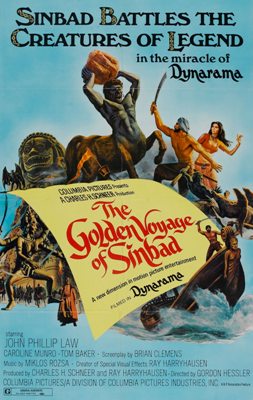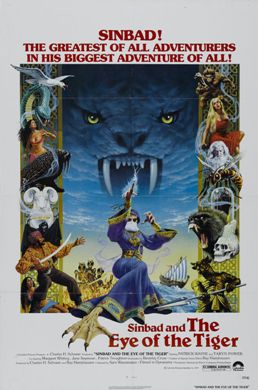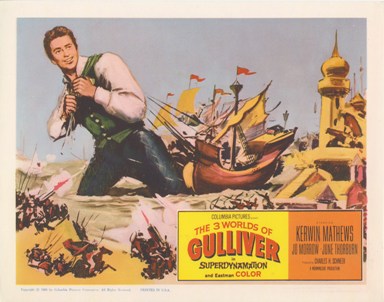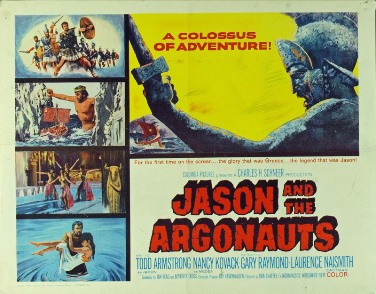Ranking Ray Harryhausen’s Fantasy Films
I think you’d be hard-pressed to find a bigger fan of Ray Harryhausen than yours truly. As a kid, I was captivated by the characters and creatures he brought to life through stop-motion animation, and it helped to cement my lifelong love of both movies and the genres of science-fiction and fantasy. With Wrath of the Titans, the sequel to the 2010 remake of Harryhausen’s Clash of the Titans, hitting theaters, this is as good a time as any to look back at Harryhausen’s films about the magic and fantastical. Here are all six of Ray Harryhausen’s fantasy films, ranked in order from worst to best.
____________________________________________________________
6. Sinbad and the Eye of the Tiger (1977)
Plot: Sinbad and crew must help a cursed prince to find a lost civilization while battling an evil witch.
Creatures: A trio of insectoid Ghouls that Zenobia the witch summons from a fire; a Baboon which is actually the cursed Prince Kassim; the Minaton, a giant gold automaton shaped like a man with a bull’s head; a Wasp that grows to the size of a bird after it drinks a magic potion; a giant Walrus that attacks the heroes; Trog, a giant horned humanoid who assists the heroes; and a Saber-Toothed Tiger which battles Trog in the climax.
Why: While it’s by no means unwatchable, this is definitely the worst of Harryhausen’s fantasy films, and a contender for the weakest film of his career. All the elements are here, but they don’t come together into a satisfying whole. The film was shot on location in Spain, Malta, and Jordan, but the finished product just looks cheap. The screenplay by Beverley Cross lacks the wit and charm of the other Harryhausen movies.
There are some talented people in the cast, but they are all under served by the material. Patrick Wayne – son of the legendary John Wayne – is clearly trying his best with what he’s given, but he comes across as out-of-place playing Sinbad as his father was playing Genghis Khan in The Conqueror (1956). Princess Farah (Jane Seymour) and Dione (Taryn Power) make for great eye candy, but serve no purpose besides being potential love interests – sure, they never get captured and need to be rescued, but they also never do anything that couldn’t have been done by other characters. I feel really sorry for Margaret Whiting, who plays the witch Zenobia, the main villain – not only is she given some truly atrocious lines and no believable motivation for what she’s doing, but she is burdened with a ridiculous pseudo-Russian accent that makes Natasha Fatale seem subtle. Patrick Troughton is a perfect fit for the old alchemist Melanthius, but the writers apparently couldn’t figure out a way to advance the plot without having him act like a complete idiot at several points. The rest of the cast fails to make much of an impression at all.
The issues with the cast and storyline wouldn’t be so much of a problem if the animation sequences were up to snuff, but unfortunately, most of them are disappointments to some greater or lesser degree. A big problem is that many of the creatures are basically real animals; as good as the animation is, the viewer is always aware they’re looking at an effect. The baboon, the giant wasp, the giant walrus, and the saber-toothed tiger all suffer from this, which greatly undermines their scenes. The three ghouls are a great design, and make for what’s probably the best scene in the film, but their scene is far too short and can’t help but invite comparison to the skeleton scene in Jason and the Argonauts, a comparison Eye of the Tiger inevitably loses. The Minaton is an awesome creature in concept, but it is given almost nothing to do; it spends most of its screentime driving Zenobia and Rafi’s boat, and ultimately meets an undignified end by being crushed under a giant stone block. By far the best effect in the film is Trog, a horned caveman-like fellow who is wonderfully designed and animated and comes across as very expressive and sympathetic. But infuriatingly, Trog meets his end at the claws of the saber-toothed cat, while Sinbad and the other heroes stand off to the side and don’t do anything until after poor Trog has been mauled to death. Ultimately, the film is worth seeing once, but you probably won’t want to see it any more times.
5. The Three Worlds of Gulliver (1960)
Plot: Impoverished English doctor Lemuel Gulliver embarks on a sea voyage that leads him to Lilliput, a land of tiny human beings, and Brobdingnag, a country of giants.
Creatures: A giant Alligator that the king of Brobdingnag forces Gulliver to battle; and a giant Squirrel that menaces Gulliver and his fiancée Elizabeth in the Brobdingnagian countryside.
Why: This is probably the least well-known of Harryhausen’s fantasy films – in fact, I myself hadn’t seen it until a few months ago. It also definitely has the smallest amount of animation of any of his films – restricted to two fairly short scenes in the second half. Much of Ray’s effort clearly went into camera tricks and photographic effects to create the vast differences in scale, and the shots hold up pretty well even today. The film is also unique in Harryhausen’s filmography, being the only one of his fantasy films based on a book, rather than on myths and legends. Even though a lot of the original novel had to be left out, the film still manages to retain a good amount of the satire from Jonathan Swift’s story – my favorite example of this is the “election” of the Prime Minster of Lilliput, in which the candidates must do things like juggling and tightrope-walking.
Because of the nature of the story, the film is much more dependent on its cast to carry the film than other Harryhausen projects. Fortunately, the cast is up to the challenge. Kerwin Mathews, who previously played the titular hero in Harryhausen’s The 7th Voyage of Sinbad, makes a likable and entertaining Gulliver, with his charisma and screen presence helping the audience overlook the fact that he is clearly American rather than English. The supporting cast, meanwhile, is a veritable who’s who of American and British character actors you’ll probably recognize if you watch a lot of movies from the fifties and sixties. My two favorites of these are Peter Bull – best known as the Soviet ambassador in Dr. Strangelove (1964) and the German captain in The African Queen (1951) – as the Lilliputian official Lord Bermogg, and Joan Hickson – who played the title character in the 1980s Miss Marple TV series – as Gulliver’s surgical patient early in the film.
As for the two animation sequences, there’s some good and some bad. The squirrel scene isn’t very exciting, and is not helped by the fact that a realistic-looking squirrel, even at giant size, is just not scary. On the other hand, the alligator scene is fantastic, and definitely the highlight of the film. The creature model is excellently designed and animated, and Kerwin Mathews does a great job of conveying Gulliver’s fear and desperation in figuring out how to fight back against the giant gator. All in all, it’s a solid little film that’s well worth checking out for Harryhausen fans who want something a little different.
4. Clash of the Titans (1981)

Creatures: The Kraken, a massive sea monster; a giant Vulture that carries Andromeda from the palace to the swamp; the winged stallion Pegasus; the deformed beast-man Calibos; Bubo the mechanical owl; Dioskilos, the two-headed dog that guards the edge of the underworld; the Gorgon Medusa, depicted here as snake-bodied as well as snake-haired; and three giant Scorpions spawned from the blood of Medusa.
Why: This was the last film of Harryhausen’s career, and probably the one that most people today will recognize by name. For this film, Harryhausen and his longtime producing partner Charles H. Schneer had the studio fully on their side, and everyone clearly wanted the movie to be something special. Veteran director Desmond Davis does a solid job guiding the picture, and Beverley Cross’ screenplay is miles better than the one he wrote for Sinbad and the Eye of the Tiger. What the film lacks in depth and complexity, it largely makes up in entertainment value and cheesy fun.
Clash of the Titans also boasts what is probably the most high-profile cast of any Harryhausen film. As Perseus, Harry Hamlin certainly looks the part of a demigod hero and handles himself well in the action scenes, but he seems out of his depth in dramatic moments alongside his more experienced co-stars. And Judi Bowker as Andromeda might be very attractive, but she is also the definition of bland and uninteresting. Fortunately, the supporting cast is more than able to pick up the slack. Maggie Smith is the portrait of quiet rage as the vengeful sea goddess Thetis, the closest thing the film has to a main villain. Burgess Meredith as Ammon, the elderly playwright, has the tough task of playing both mentor and comic relief, but he pulls it off. As the deformed Calibos, Neil McCarthy does an excellent job of acting under heavy makeup, and arguably makes him more sympathetic than the filmmakers intended. And while he may have just been cashing a paycheck, it is very fun to see Laurence Olivier play Zeus with all his scenery-chewing gusto.
The film’s larger budget definitely shows in the animation sequences, which it boasts more of than any of Harryhausen’s other movies. The clear standout scene of the film is the Medusa sequence, which is definitely some of the best animation of Harryhausen’s career. Medusa herself is a magnificently designed creature, a combination of humanoid upper body and snake tail that could only have been created via animation. She has skill with a bow and arrow in addition to her power to turn people to stone with a glance, making her a truly formidable adversary. The rattle on her tail adds a creepy audible element to her sequence. Her motions are deliberate and measured as she hunts Perseus and his men, contrasting with the writhing snakes on her head. To top it off, the entire scene is lit by flickering fire, which, like the creature model, had to be painstakingly adjusted one frame at a time by Harryhausen. The other truly great creature in the film is the Kraken, a gigantic sea monster that seems like a cross between the Gillman from Creature from the Black Lagoon (1954) and the Ymir from Harryhausen’s own 20 Million Miles to Earth (1957). The two most impressive things Harryhausen does with the Kraken are creating a vast sense of scale and the extremely difficult task of having an animated character interact with water. I also have to mention the giant scorpions, which come off orders of magnitude better than other attempts to animate real animals, because the arachnids are naturally articulated and therefore lend themselves perfectly to stop-motion. The animated version of Calibos, used to depict his more inhuman traits, is intercut with Neil McCarthy in his makeup as well as the filmmakers can manage. The giant vulture and Dioskilos the two-headed dog are both reasonably successful in their brief sequences. And while I know some people hate him to a degree normally reserved for the Star Wars prequels, I’ve never had a problem with Bubo the mechanical owl. These films were always meant for a family audience, so I don’t see the issue with having a cute creature designed to appeal to kids. But then, I’m one of those apparent freaks who actually likes the Ewoks, so what do I know?
While it hasn’t aged as well as some of the other Harryhausen films, Clash of the Titans is still well worth checking out, whether you want to compare it to the 2010 remake, or you just want an entertaining, cheesy fantasy epic.
3. Jason and the Argonauts (1963)
Plot: The hero Jason leads a group of adventurers to search for the legendary Golden Fleece.
Creatures: Talos, the colossal metal warrior who guards the Isle of Bronze; two winged Harpies who torment the blind prophet Phineus; the seven-headed Hydra that protects the Golden Fleece; and seven living Skeletons who battle Jason and crew in the climax.
Why: This is the movie that both Harryhausen and Schneer considered their favorite of the films they made together. It was also their first movie based on classical mythology, which they would revisit in Clash of the Titans. Don Chaffey, who would work with Ray and Charles again on One Million Years B.C. (1966), does an admirable job as director. Bernard Herrmann, in his final time working with Harryhausen, delivers a musical score that defines “epic.” Beverley Cross’ screenplay is better than the ones he did for Clash of the Titans and Sinbad and the Eye of the Tiger, and he does a great job adapting the very episodic myth into a movie structure.
The cast does solid work across the board. As Jason, Todd Armstrong does a great job with the closest thing to an antihero in the Harryhausen canon. Michigan native Nancy Kovack makes an exotically beautiful Medea. Gary Raymond is appropriately slimy as the treacherous prince Acastus. Laurence Naismith brings a great world-weariness to Argos the shipwright. John Cairney perfectly captures the tragic innocence of Hylas. As the blind prophet Phineus, Patrick Troughton gets to play a much better version of the wise old man than he later did in Sinbad and the Eye of the Tiger. But there are two performances in particular that I want to single out for praise. Nigel Green as Hercules is my favorite depiction of the character in anything ever – a loud, boisterous, powerhouse of a man who doesn’t think things through, but has a heart of gold and is a fiercely loyal friend. The other standout in the cast, in my opinion, is Honor Blackman – best known for playing Pussy Galore in Goldfinger (1964) – as the goddess Hera. Her verbal chess matches with her husband Zeus (Niall MacGinnis) are some of the best-written scenes in the film.
Surprisingly, Jason and the Argonauts has the smallest number of creature scenes of any Harryhausen fantasy film – only four of them – but all four scenes are very good. The bronze giant Talos is easily the most frightening of Ray’s creatures, particularly the contrast between his complete lack of a voice and the shifting, creaking sounds of his body in motion. The harpies are fittingly loathsome and hideous, coming across like giant bats or pterosaurs. The Hydra is an amazing creature design, and it is staggering to think about Harrhausen’s painstaking task of animating its seven writhing heads frame by frame. But by far the best scene in the film is the climactic battle, where Jason and two of his comrades face the “Children of the Hydra’s Teeth” – seven living skeletons armed with swords and shields. The choreography and staging of the scene are still amazing today, especially one particular moment where, in one unbroken shot, one skeleton charges at Jason with a spear, and he grabs the spear out of its hands and strikes the skeleton with its own weapon. The skeleton sequence is the best scene in this movie, one of the most iconic scenes in fantasy filmmaking, and arguably the single greatest achievement of Ray Harryhausen’s career. Though the film may only take the bronze medal spot in Harryhausen’s fantasy filmography, it is still a movie any fan of the fantasy genre owes it to themselves to see.
2. The 7th Voyage of Sinbad (1958)
Plot: When his beloved is cursed by an evil magician, Sinbad must travel to an island of monsters to break the curse and prevent a war.
Creatures: Two of the giant Cyclops that rule the island of Colossa; the Snakewoman that Sokurah the magician creates by magically combining a servant woman and a cobra; the Roc, a gigantic two-headed bird that nests on the island peaks; the Dragon that guards the entrance to Sokurah’s castle; and a living Skeleton that Sinbad must duel.
Why: The first of Ray’s fantasy films is also one of his best. Harryhausen and Schneer made this film because they wanted to move beyond science-fiction movies about monsters attacking cities, and it’s hard to argue with the results. The film is excellently directed by Nathan Juran, who previously worked with Harryhausen on 20 Million Miles to Earth (1957), and would again on First Men in the Moon (1964). The score by Bernard Herrmann, in his first of four collaborations with Harryhausen, is excellent. The screenplay by Kenneth Kolb is quite witty and maintains a fun, storybook tone. Unlike many of Harryhausen’s other films, which take a while to get going, The 7th Voyage of Sinbad wastes no time to start firing on all cylinders. Within the first ten minutes, Sinbad and his crew are fleeing from a giant Cyclops, and the pace rarely lets up from there.
The cast all seem like they’re greatly enjoying themselves, and their enthusiasm is infectious to the viewer. As Sinbad, Kerwin Mathews is right at home playing the swashbuckling hero, and his screen presence and charisma help us look past the fact that the legendary Arabian sailor is being played by a white American. Kathryn Grant makes the most of her role as Princess Parisa, even though her character is mostly just there to be Sinbad’s love interest and provide the motivation for his quest. Torin Thatcher is clearly having the time of his life playing the evil magician Sokurah, and ends up with many of the most memorable lines in the film, thanks to his gloriously hammy delivery. Child actor Richard Eyer, in what would be his final movie role, strikes the right balance of endearing and eerie as Barani the genie. And I want to bring special attention to Alfred Brown as Sinbad’s right-hand man Harufa – while the part could have been the stereotypical coward sidekick, Harufa is shown to be cautious instead of cowardly, a determined fighter when push comes to shove, and an utterly loyal friend to Sinbad. When Harufa is killed by Sokurah, it is surprisingly impactful, and Sinbad is clearly grieved when he later finds his friend’s body.
But of course, what the film is most famous for is its animation sequences, which are top-notch and set a high bar for the future Harryhausen films. The most famous and iconic, quite appropriately, are the Cyclops, which Ray imbues with both personality and menace. The other best-remembered scene is Sinbad’s duel with the skeleton, a subject which Harryhausen would revisit on a much larger scale in Jason and the Argonauts. And I would be remiss to not mention the dragon, a magnificently designed creature whose fight with one of the Cyclops serves as the climax of the film. The other two creatures, the snakewoman and the Roc, are also unique and memorable in their own ways. In terms of its impact on future filmmakers, The 7th Voyage of Sinbad plays a similar role to what the first Star Wars would play a generation later, and much like George Lucas’ original classic, it deserves to be seen again and again.
1. The Golden Voyage of Sinbad (1974)

Plot: Sinbad and his crew are drawn into a voyage that leads them across the seas in search of an ancient treasure, while trying to stop an evil sorcerer who seeks the same prize.
Creatures: The Homunculus, a tiny gargoyle-like beast that Koura the sorcerer uses as his spy; the Figurehead of Sinbad’s ship, which Koura brings to life; a living statue of the six-armed goddess Kali, who fights against Sinbad and his men with six swords at once; a giant one-eyed Centaur with a David Bowie haircut; and a Griffin which fights the Centaur in the film’s climax.
Why: I know this goes against the dogma of the Church of Harryhausen, but I have to say it: The Golden Voyage of Sinbad is a better film than Jason and the Argonauts or The 7th Voyage of Sinbad. Gordon Hessler does a great job in the director’s chair, creating some excellent shots and staging. The screenplay by Brian Clemens, from a story he co-wrote with Harryhausen, keeps things moving at a fast pace and is filled with funny, memorable lines.
It also definitely has the best cast of any of the Harryhausen fantasy movies. John Phillip Law is a perfect fit for the role of Sinbad; handsome and dashing as a storybook hero should be, convincingly badass in fights and action scenes, and with enough touches of wit and humor that we want to keep following the character. Tom Baker – best known as the fourth incarnation of the title character on Doctor Who – does a fantastic job as the evil sorcerer Koura, making full use of his expressive face and physical presence to create an intelligent villain who is also capable of going toe-to-toe with Sinbad. Margiana the slave girl, played by B-movie goddess Caroline Munro, is definitely the best female lead in any of Harryhausen’s fantasy films – besides being incredibly gorgeous, she and Law have great chemistry, and she actually gets to save Sinbad’s life at one point. Douglas Wilmer as the Vizier not only rises to the challenge of playing a character who wears a completely immobile mask for almost the entire film, but also averts one of the most common cliches of Arabian Nights stories – not only is the Grand Vizier not the villain, he is a mentor and adviser to the heroes. And Kurt Christian, playing the lazy, shiftless, but good-hearted Haroun, manages the difficult task of being a comic relief character without becoming annoying. Unlike the other two Sinbad movies, the filmmakers made an effort here to make the cast look like they are Middle Eastern using makeup and accents, which I greatly appreciated. After so many Arabian Nights movies populated by barely-tanned white people speaking mock-British accents, this is quite refreshing.
Ironically, the only area where The Golden Voyage of Sinbad comes up short compared to its more famous predecessors is the animation sequences – none of them are bad, but none of them are as iconic as the Cyclops in The 7th Voyage of Sinbad or the Skeletons in Jason and the Argonauts, with one exception. That exception is the Kali sequence, which is absolutely fantastic from start to finish. It begins with Koura bringing the statue to life and making it dance, and ends with Kali wielding six swords at once against Sinbad and his entire crew. The other scenes are good, particularly the fight between Sinbad’s crew and the animate figurehead of their ship, and the climactic battle between the Centaur and the Griffin, but none of them rise to the level of the Kali scene. Bottom line, this is the best of Harryhausen’s fantasy films, and probably the best film of his career.






